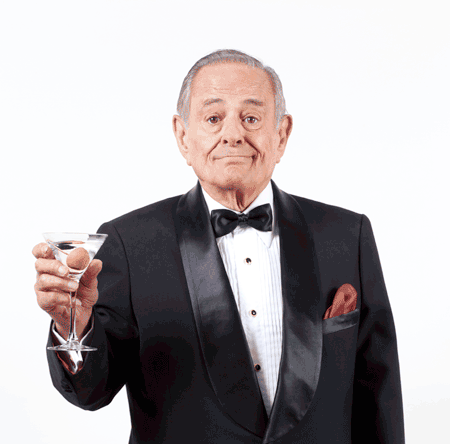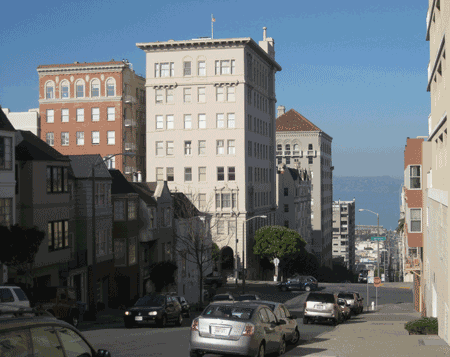
Maurice Kanbar is back with a new vodka.
SPIRITS | Chris Barnett
Maurice Kanbar is sitting in the cluttered, comfortable living room of his Pacific Heights apartment clipping Safeway coupons.
That seems rather odd for an 80-year-old entrepreneur, property investor and filmmaker-philanthropist who’s no doubt a billionaire plus. But then he also zips around town on a Vespa lookalike motor scooter because he hates to waste time trolling for parking places. And he eats lunch at the same restaurant practically every day when he’s in town: Perry’s on Union Street.
Kanbar is a man in motion — an obsessive, compulsive inventor with a near Midas touch who dreams up many of his ideas in his own kitchen. Then he gives his brainstorms a clever name, an eye-grabbing package and pitches them like a carny barker. No MBA marketing mumbo-jumbo or Silicon Valley techno-babble. Just plain English. A prime example is D-Fuzz-It, a gadget expressly designed to remove fuzz balls from sweaters.
But many San Franciscans who enjoy elbow-bending know that Kanbar’s greatest triumph by far among his 35 or so patented creations is Skyy vodka, the first of its breed born, bred and branded in the city. A lifelong martini lover, Kanbar made his bones in the booze business in 1992 when he debuted the smooth vodka he developed by distilling alcohol, grain and water four times and filtering it through charcoal and cardboard three times to remove the particulates that give vodka its bite, burn or headache.
When seasoned distillers launch a new spirit, they usually deploy an army of market researchers, hire a pricey “naming” company, a platoon of ad staffers, publicists and fetching young things to give away cocktails at trendy bars. Then the distillers — indeed any company selling something new to consumers — stage focus groups to capture consumer feedback, sift the data and roll the dice, hoping to come up with a distinctive brand.
Not Kanbar. He found quizzing strangers in a sterile room with a tape recorder running more “hocus pocus” than focus; he went with his gut.
When he was considering launching his spirit, Russian-sounding Smirnoff was the top selling American-made vodka and had been for decades. It sold for $9 to $10 but its cachet had waned. Imports like Absolut (Swedish) and Stolichnaya (authentically Russian) were invading the U.S. and bombarding the younger vodka fans, who longed for hipness with clever ads and a $15 price tag. In the vodka derby then, it was Plymouth vs. BMW.
Kanbar says he got in the race with his uber smooth vodka priced at $12.99, halfway between old reliable Smirnoff and the rising tide of foreign-made vodkas. But price alone wasn’t going to grab attention. And while he had taste going for him, his entry had no style.
“Originally, Maurice wanted go with a clear, see-through bottle — like every vodka brand — but he knew it would be lost in the emerging clutter of vodkas in better bars,” recalls Eli Bishop, a brand manager who has worked for Kanbar since the early 90s. “Then he found a package designer in Wales who perfected a cobalt blue bottle and solved that problem.”
Says Kanbar: “With a blue bottle, I wanted to call it Sky but, no surprise, someone already had the name. So I just added another Y.”
Skyy’s success — today, it’s the second best selling American-made vodka — is another story for another time. In 2004, Kanbar sold the company in two chunks to Italy’s Groupo Campari for somewhere between $450 million to $500 million and a multi-year noncompete clause.
“I made a mistake in pricing Skyy a little less than Absolut and a little more than Smirnoff,” he says. “I should have priced it above Absolut. I would have made a lot more money. But then I make mistakes.”
Kanbar hasn’t spent the last seven years just clipping coupons. He’s been in his kitchen tinkering, tasting and tracking the explosive growth of the global vodka market. As it happens, he could choose from eight kitchens; he not only owns his full-floor apartment, he bought the entire eight-story building at 2100 Jackson, using it as a combination private residence, lab and think tank for his company and occasionally as a bunkhouse to keep an assortment of film friends and others nearby.
Today, with his noncompete clause expired, Kanbar is back in the vodka game full force. His newest libational venture is called Blue Angel, a new entry in the “ultra premium” category where his competitors are fetching upwards of $75 for vodka in bottles that look like pieces of art. However, entering 2012, the arena is filled with hundreds of brawny gladiators and boutique brands from around the world, including a half-dozen or so other “made in San Francisco” vodkas.
Despite the competition, Anthony Dias Blue, who runs the annual San Francisco World Spirits Competition and is editor-in-chief of The Tasting Panel magazine, is betting on Kanbar’s distilling artistry and marketing savvy to give Blue Angel liftoff. “Maurice is one of the most interesting, inventive people I’ve ever met,” he says. “The first time I met him for lunch, he arrived on his scooter wearing some cockamamie vest he invented that had a million pockets,” recalls Blue.
 Kanbar admits he isn’t really launching Blue Angel; it’s a relaunch. The brand’s first promotional ascent a year ago didn’t attain any real altitude and he shoulders the blame. “People didn’t like the original bottle or the price: $28,” he says. “If someone was going to plunk down 28 bucks, they’d buy Grey Goose or something they knew.”
Kanbar admits he isn’t really launching Blue Angel; it’s a relaunch. The brand’s first promotional ascent a year ago didn’t attain any real altitude and he shoulders the blame. “People didn’t like the original bottle or the price: $28,” he says. “If someone was going to plunk down 28 bucks, they’d buy Grey Goose or something they knew.”
He recalls the first Blue Angel bottle was frosted (like Goose, Belvedere and Chopin) and festooned with clouds, a halo and equipped with a short neck. Another blunder. “We had production problems with that bottle so we changed to a clear, thinner version that has sort of a retro feel,” Kanbar says. He also plays the nostalgia card. “We show it on a stage, in the spotlight, playing on its San Francisco heritage.”
What’s more, as part of the relaunch he dropped the price from $28 to $19.95 and offers a $3 coupon downloadable from blueangelvodka.com that cuts the cost even more. Spirits expert Andy Blue contends that if Kanbar “maintains the quality Blue Angel had when it was much more expensive, it will do very well.”
But first Kanbar has to get the Angel off the shelf and in a glass, no small feat today when buzz is the holy grail in the spirits world. As part of the relaunch, the inventor himself says he is “pounding the pavement, educating bartenders to our ultra pure vodka, holding happy hours in San Francisco’s top bars. Gotta do it. No one calls you up and says, ‘Your vodka’s wonderful. Tell us everywhere we can buy it.’ Just getting in the door is tough enough when you’re unknown.”
On Fillmore, Blue Angel is on the backbar at the Elite Cafe and Florio.
Kanbar and his team are taking a page out of a politician’s playbook to generate word of mouth and, hopefully, sales. Instead of hyping his new vodka with a ‘try it, you’ll like it’ message, he’s pushing the classic cocktail – the martini — with a twist, calling it the BAM. When he and his marketers swoop into a saloon or a high volume liquor store, they pass out BAM buttons to promote the Blue Angel Martini. In bars, he freely gives away samples. He’s also invented another version of the martini called the Blue BAM, replacing vermouth with Blue Curaco. Then there’s the Cran BAM using cranberry juice. Kanbar’s goal is to make it as popular as the Cosmopolitan.
“My favorite drink is a martini, but I never liked gin,” he says, “If I had one and got back to the office, I smelled like a gin mill. Or, you promise your wife you’re not going to drink, then you come home after two Scotch and sodas and she knows. With a BAM vodka martini, no one knows.”
Describing the difference between Skyy, a premium vodka, and Blue Angel, an ultra premium, Kanbar becomes uncharacteristically reluctant to talk. “We’ve developed a process where we can age Blue Angel for 10 years to give it its smooth taste, but do it in two weeks,” he says. “It’s a proprietary process. I won’t even patent it because then everyone will know.”

Martini friends: Kanbar with Gov. Jerry Brown and former mayor Willie Brown
A HALF CENTURY OF IDEAS AND GENEROSITY
Among the inventions, investments and substantial gifts of Maurice Kanbar over the years:
At 21, he dreamed up D-Fuzz-It, a “comb” to remove fuzzballs from sweaters. At 26, he created a nylon fiber to compete with giant DuPont Corporation, sold his company 14 months later and could have retired for life but didn’t. Then there’s Soo-Foo, a pound of natural brown rice, grains and lentils with 5 grams of protein per serving available today in health food stores. His Vermeer Dutch chocolate cream liqueur competes against Godiva liqueur. Other products include Tangoes puzzle game, the Safetyglide hypodermic needle protector, a cryogenic cataract remover and ZIP Notes, which are sticky notes on a roll.
He has written hefty checks to benefit a number of major institutions in the neighborhood, including the Kanbar Cardiac Center at California Pacific Medical Center, the Kanbar Hall theater at the Jewish Community Center and a headquarters for the San Francisco Girls Chorus.
A lifelong movie buff, he is a major supporter of the San Francisco International Film Festival and Film Society, along with KQED’s ImageMakers series of indie films. The Brooklyn-born Kanbar funded the Kanbar Institute of Film, Television and New Media at New York University. He is credited with creating New York’s first multiplex theatre and established Kanbar Entertainment, which produced an animated film called Hoodwink that topped $100 million in global sales. He has other films in the pipeline.
Kanbar has stumbled, too. He and longtime New York investment banker pal Henry Kaufman bought a slew of vintage buildings in downtown Tulsa and were planning to convert them to live-work lofts, galleries and shops and turn the city into a “magnet for the arts,” says okctalk.com, which reported that Kanbar pumped $100 million into Tulsa real estate. The partnership and friendship soured and they ended up suing each other.
Meantime, Kanbar has penned his memoir, Secrets From an Inventor’s Notebook, which, no surprise, was produced by his own publishing company, Council Oaks Books. But his life and times are taking a backseat to his current passion: introducing the Bay Area Martini to the Bay Area and eventually to the world. ”Barkeep, I’d like mine very dry, straight up with two Dirty Sue olives.” Yep, Maurice Kanbar is now getting into the garnish game.
Filed under: Food, Drink & Lodging, Locals





